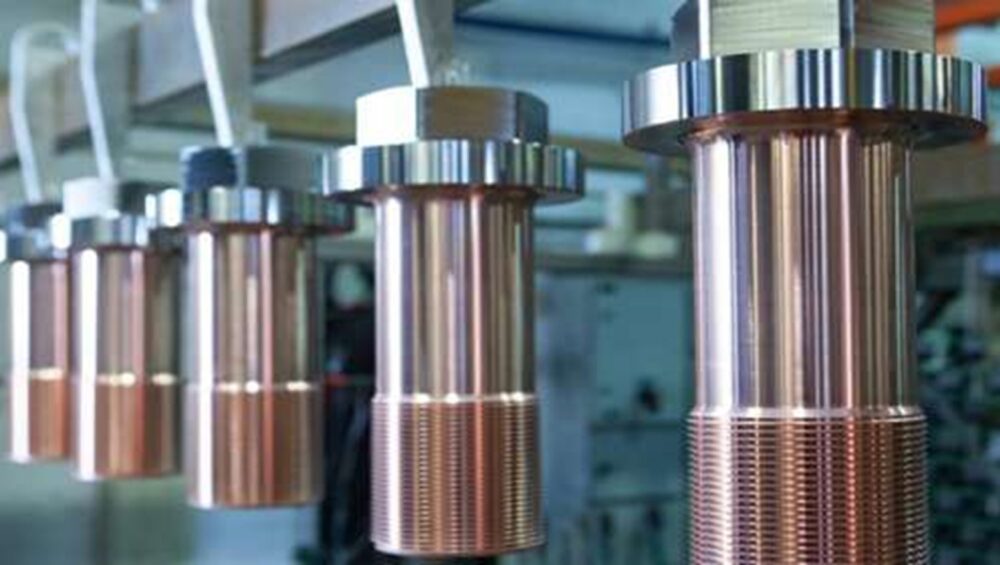Electroplating, also known as electrodeposition or electroplated coating, coats metal with a thin layer of another metal using electrolysis. It strengthens the metal’s corrosion resistance. Electroplating alters physical characteristics. The alteration in physical characteristics improves aesthetics, corrosion prevention, and wear resistance. Electroplating improves metal beauty, special surface, engineering, and mechanical qualities. Electroplating in UAE uses copper, nickel, gold, silver, chrome, zinc, tin, rhodium, and aluminium most often.
Four main parts make up this process.
Anode: A positively charged electrode is used in the circuit. The anode holds plating metal.
Cathode: The circuit’s negatively charged electrode. It holds the substrate, or plate material.
Plating Solution: A crucial metal finishing solution. It facilitates circuit electrical flow as a catalyst. Copper sulphate and metal salts are typically in the plating solution.
Power source: Circuit current comes from the power supply. When connected to the anode, the power source supplies electricity.
How Electroplating Works
Insert the metal anode and substrate into the plating solution or electrolyte. Add power to the arrangement via the anode.
Thus, anode oxidation occurs when electricity is applied. The plating solution dissolves metal atoms as positive ions. Metal ions (positively charged ions) migrate to the negatively charged substrate due to the circuit current. This deposits a thin metal layer on the substrate. To ensure successful electroplating, remember these points. First, electric current quality impacts plating. Here, quality comprises voltage and current application time. Second, the electrolyte’s chemical composition and temperature affect process efficiency. Finally, always consider anode-cathode distance. This is because the distance dissolved metal ions travel to the substrate also affects plating effectiveness.
Electroplating precautions
- Since the solution contains sulfuric acid and is corrosive, handle it carefully. If a solution or electrolyte goes into your eyes, clean them well and call a doctor.
- Please wear goggles and gloves during this process to avoid electrolyte contact with the skin. An apron and fume hood are also essential. Use the fume hood to keep electrolyte fumes out of your face.
- Keep plating solutions away from pets and children.
- Electrolytes should not touch household chemicals. Contact could destroy the electrolyte or create harmful gases.
- Storage of electrolytes should be between 40 and 95 degrees Fahrenheit. Keep it in the original container with the lid secured.
- Always use a plastic funnel to distribute the electroplating kit electrolyte.
- Be careful with electricity when doing this. Rubber mats, grounding, fusing, and insulated gloves.
- Avoid wearing rings and other metallic jewellery throughout the treatment to avoid electrocution.
Three electroplating methods
Barrel Plated
This movement tumbles the substrate in the barrel, allowing homogeneous coating metal application. Thus, engineers utilise this type to improve substrate appearance and corrosion resistance. Engineers also utilise barrel plating to increase substrate wear resistance. It also makes plating high-volume items cheaper by allowing many substrates in the barrel. This makes barrel plating perfect for fasteners and stampings. Since it uses a modest electrical current, plating takes longer.
Rack-plating
Rack and barrel plating differ. The substrate remains stationary. This approach restricts mobility compared to barrel plating. It also uses metal racks with spring fingers, cables, or screws to attach substrates. Thus, electrolyte immersion immobilises the substrate.
Additionally, engineers use rack plating for fragile items. Parts may struggle with barrel plating’s tumbling. Rack plating is also ideal for big or complex substrates. Engineers choose it for high-quality finishes in medical, electrical, automotive, defence, and military devices. However, rack plating is labour-intensive and expensive. This plating approach protects substrates during plating.
Reels-to-reels plating
REEL-TO-REEL plating is cost-effective and efficient. Selective metal deposition on a substrate makes it a unique plating procedure. Engineers gain more from reel-to-reel plating, which is used to plate strips of produced or stamped items.
There are several reel-to-reel plating kinds.
- Managed Depth Plating: Only both substrate edges are plated. Not found elsewhere.
- Spot plating: Mask-based reel-to-reel plating. Here, metal deposits exclusively in uncovered spots.
- Flat Stock: Like spot plating, flat stock deposits metal on uncovered substrates. They differ solely in the absence of spot plating.
- The reel-to-reel Tape Masking plating method deposits metal on a substrate in a continuous strip. It’s vital to hide non-plating parts with tape.
Reel-to-reel plating is best for plating a specific substrate region. Due to its high plating rate, substrate conductivity and durability improve. Materials coated this way are corrosion-resistant and durable. Additionally, this plating approach saves money on high-volume applications.
Electroplating-Suitable Metals
Electroplating in Dubai uses one or more metals. Engineers employ various metals for this technique. The most often utilised metals are below.
- Copper electroplating improves layer adhesion. It boosts substrate conductivity and heat resistance.
- Zinc resists corrosion. Electroplating with zinc-nickel enhances substrate resistance to air corrosion.
- Nickel is wear-resistant and good for electroplating. Its alloys provide elemental resistance, conductivity, and hardness substrates.
- Silver plating is malleable and ductile. It looks good and resists contact wear well. Silver boosts electrical and thermal conductivity.
- Palladium: Used for its corrosion resistance, palladium also hardens the substrate.
- Gold is an attractive precious metal. It also gives substrates strong conductivity, tarnishing, corrosion, and wear resistance.
- Tin: Cheap and eco-friendly, this colourful metal. Used, it renders substrates corrosion-resistant and bendable.
Applications of Electroplated Parts
Electroplating is used in many sectors. Let’s analyse some.
Aerospace: Aircraft components are exposed to wide temperature variations, therefore coating extends their longevity. It also makes base metal wear-resistant.
Automotive: Automotive businesses electroplate chromium and nickel on automobile and motorbike parts for aesthetics.
Dental and Medical: Electroplated parts are used in forceps, implants, replacement joints, screws, and plates. This coating strengthens them against corrosion.
Prototyping: Since prototyping custom or low-volume metal products are expensive, manufacturers now use 3D printing. This saves time and money.
Power: Electroplating electrical or solar power transmission objects dramatically improves conductivity. Also, it increases durability.
Jewellery: This method is perhaps most used in this industry. Manufacturers use this method to make bracelets, rings, pendants, etc. look and last longer.
Electroplating in Dubai is a long-standing technology. It helps make stronger, more durable, and more attractive parts. An anode, cathode, electrolyte, and power source are needed for electroplating. Want to electroplate something? Risky without sufficient advice or training. You should visit at Classical Metal, electroplating in UAE.







